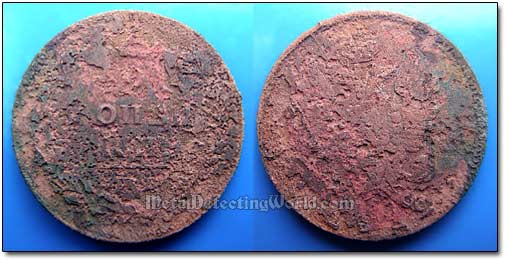How To Clean Coins with Electrolysis - A Detailed and Illustrated Tutorial, page 2
1. Introduction to Electrolysis
1) What is Electrolysis?
Electrolysis (or Electrolytic Reduction) is decomposition of an ionized solution (electrolyte) by means of applying a direct electric current (DC) to an electrolytic cell which consists of four components: a vat, an electrolyte - an electricity-conducting solution of water in which ions are dissolved, a negative cathode with a coin to be cleaned, and a positive electrode - anode.
Supplied by an external DC power source, electric energy sets in motion and maintains an otherwise non-spontaneous redox chemical reactions at the electrodes, which cause decomposition of water into the diatomic molecules of hydrogen (H2) and oxygen (O2).
The electrolytic cleaning is mainly based on mechanical action of the gaseous hydrogen evolving off both the cathode (a negative electrode) and an object that is attached to the cathode. This mechanical action separates materials (dirt, gunk, corrosion, etc.) from the coin's base metal surface.
An ANODE is the positive terminal of the electrolytic cell, to which electrons, negatively charged ions - anions, or colloidal particles drawn from the coin's surface, travel when an electric current is passed through the cell. An oxidation half-reaction takes place at the anode, and gaseous oxygen is evolved and gets mixed up with hydrogen evolving from the cathode in vapors.
During the electrolytic coin cleaning, the anode will not be covered (electroplated) with gunk, and the electrolyte bath will not turn into a nasty mess, because, unlike in the electrolytic removal of rust off the iron objects, the chemical reactions that caused the encrustation and tarnish on coins can not be put in reverse by the electrolytic removal of corrosion from any non-ferrous object. The corrosion layers are only mechanically removed off the coins by the evolved hydrogen. Some discoloration of the electrolyte solution occurs as dirt and gunk are released into it and fall to the bottom.
The chief advantage of electrolytic reduction is that the density of the externally applied electromotive force (EMF), or direct electric current, can be controlled. This control enables the conservator to select a high current density, thus increasing the hydrogen evolvement, in order to mechanically remove any hard oxidized crust off the coin.
If you would like to learn more about Direct Current, Electrolyte and Electrodes, please visit Page 3 of my "Electrolytic Rust Removal" tutorial.
2) IS COIN ELECTROLYSIS ALWAYS PRACTICAL?
The electrolytic coin cleaning process (commonly called electrolysis, electrolytic reduction, zapping, nuking, or frying) can be selected exclusively for its mechanical cleaning action of the evolved hydrogen. Although the electrolytic reduction cleaning is one of the most efficient methods of removing really hard rock, mineral coatings off coins, and electrolytic units are cost-effective and simple to set up and maintain, this cleaning method is only suitable for coins that retain the well-preserved surfaces, and NOT practical for cleaning the coins damaged by corrosion.
Corroded copper-base alloyed coins, especially encrusted ancient Roman coins (no matter how hard they are to clean), should NOT be subjected to electrolysis for the following reasons:
1) Copper-alloyed coins are the most susceptible to adverse effects of corrosion and oxidation, and their surfaces incur substantial damage (pitting and indentations) caused by encrustation of verdigris and "bronze disease".
In some cases, a bronze coin may be completely consumed by encrustation leaving no base metal underneath. In this case, after the electrolytic cleaning decomposes and removes all the corrosive encrustation off, the coin is no longer present in the vat! Also, severely corroded thin coins may crumble away to nothing when subjected to electrolysis.
"Zapping" the less damaged coin to its bare metal can make the coin look ugly because of disclosure of a pitted surface that may not have been visible under the corrosion layer.
Severe Corrosion Damage Is Revealed After Electrolytic Treatment
